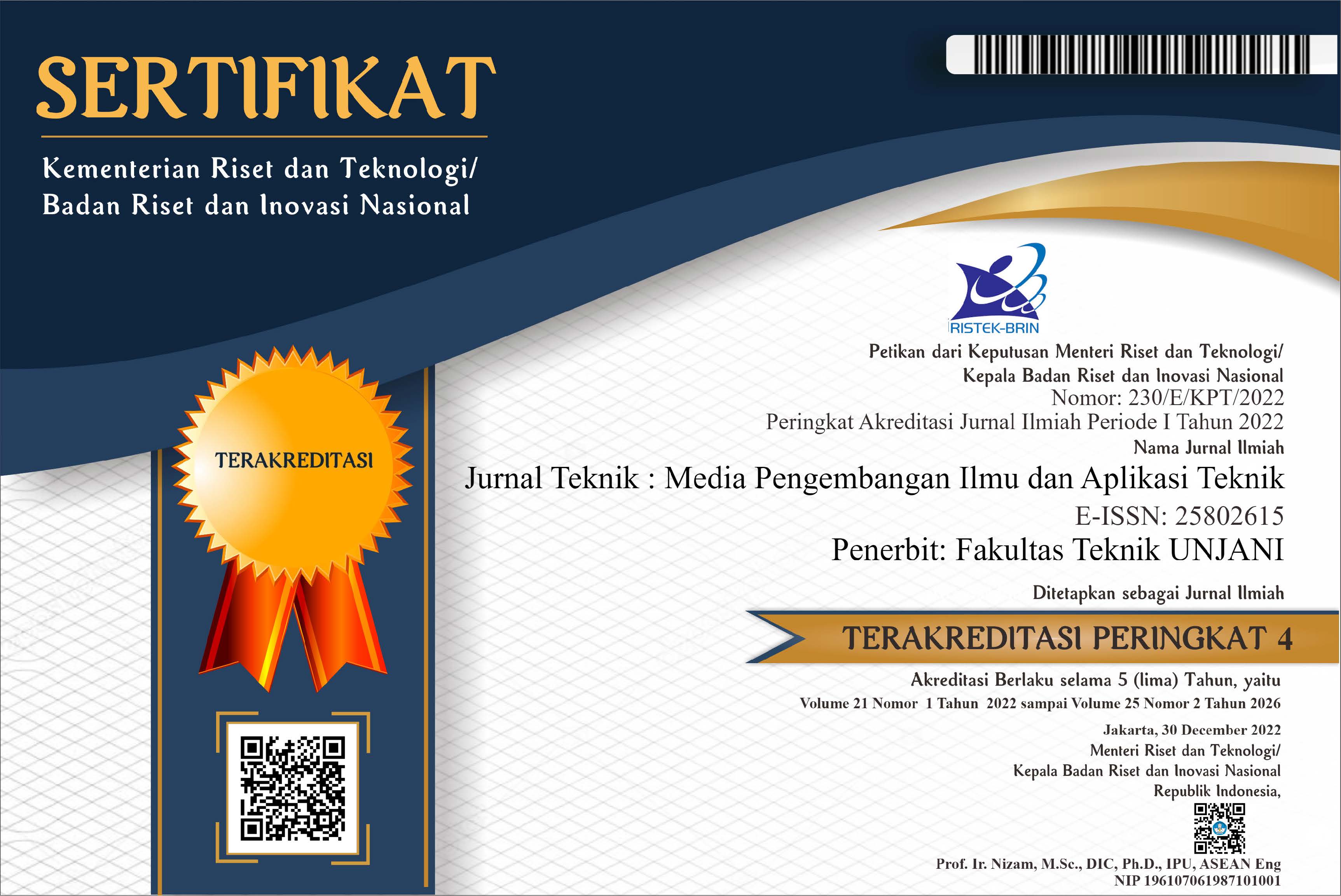Studi Pengaruh Konsentrasi Katalis ZnO untuk Degradasi Limbah Palm Oil Mill Effluent (POME) Menggunakan Teknologi Fotokatalitik
DOI:
https://doi.org/10.55893/jt.vol22no2.549Kata Kunci:
POME , fotokatalitik, COD, radikal, ZnOAbstrak
Indonesia merupakan salah satu negara center market kelapa sawit terbesar di dunia sehingga perkembangan industri kelapa sawit dalam negeri tumbuh dengan sangat pesat. Namun, meningkatnya aktivitas perdagangan kelapa sawit berdampak terhadap meningkatnya limbah yang dihasilkan yaitu Palm Oil Mill Eflluent (POME). Mayoritas pabrik saat ini masih menggunakan open pond sebagai teknologi pengolahan POME, namun penggunaan teknologi ini dinilai belum efektif untuk pengolahan POME. Fotokatalitik merupakan teknologi berbasis energi sinar (UV, tampak, sinar matahari) untuk menghasilkan senyawa radikal yang dimanfaatkan sebagai agen pengoksidasi limbah POME. Katalis yang digunakan pada penelitian ini adalah ZnO. Berdasarkan hasil karakterisasi XRD dan UV-vis DRS, struktur kristal dari ZnO adalah hexagonal wurtzite dengan energi celah pita sebesar 3,22 eV. Berdasarkan hasil uji aktivitas degradasi fotokatalitik limbah POME, diperoleh bahwa penggunaan katalis ZnO dengan konsentrasi 0,5 g/L dinilai cukup efisien untuk mendegradasi kandungan organik pada limbah POME dengan persentase reduksi chemical oxygen demand (COD) mencapai 22,85%, warna 48,53% dengan konstatnta laju reaksi COD (k) adalah 2,6´10-3 menit-1.
Unduhan
Referensi
Abdullah, H., Khan, M. M. R., Ong, H. R., & Yaakob, Z. (2017). Modified TiO2 photocatalyst for CO2 photocatalytic reduction: An overview. Journal of CO2 Utilization, 22(March), 15–32. https://doi.org/10.1016/j.jcou.2017.08.004
Ameta, R., Solanki, M. S., Benjamin, S., & Ameta, S. C. (2018). Photocatalysis. Dalam Advanced Oxidation Processes for Wastewater Treatment: Emerging Green Chemical Technology (hlm. 135–175). https://doi.org/10.1016/B978-0-12-810499-6.00006-1
Badrun, Y., Retnawati, S. F., Fauzi, M. R., Harahap, I., & Anggraini, D. A. (2019). Analisis pencemaran sungai Rokan akibat kegiatan pabrik kelapa sawit. 2018, 24–36.
Charles, A., & Cheng, C. K. (2019). Photocatalytic treatment of palm oil mill effluent by visible light-active calcium ferrite: Effects of catalyst preparation technique. Journal of Environmental Management, 234, 404–411. https://doi.org/10.1016/j.jenvman.2019.01.024
Charles, A., Khan, M. R., Ng, K. H., Wu, T. Y., Lim, J. W., Wongsakulphasatch, S., Witoon, T., & Cheng, C. K. (2019). Facile synthesis of CaFe2O4 for visible light driven treatment of polluting palm oil mill effluent: Photokinetic and scavenging study. Science of the Total Environment, 661, 522–530. https://doi.org/10.1016/j.scitotenv.2019.01.195
Cheng, C. K., Deraman, M. R., Ng, K. H., & Khan, M. R. (2016). Preparation of titania doped argentum photocatalyst and its photoactivity towards palm oil mill effluent degradation. Journal of Cleaner Production, 112, 1128–1135. https://doi.org/10.1016/j.jclepro.2015.06.104
Cheng, C. K., Rizauddin Derahman, M., & Khan, M. R. (2015). Evaluation of the photocatalytic degradation of pre-treated palm oil mill effluent (POME) over Pt-loaded titania. Journal of Environmental Chemical Engineering, 3(1), 261–270. https://doi.org/10.1016/j.jece.2014.10.016
Cheng, Y. W., Chang, Y. S., Ng, K. H., Wu, T. Y., & Cheng, C. K. (2017). Photocatalytic restoration of liquid effluent from oil palm agroindustry in Malaysia using tungsten oxides catalyst. Journal of Cleaner Production, 162, 205–219. https://doi.org/10.1016/j.jclepro.2017.06.023
Hodzic, A., Madronich, S., Kasibhatla, P. S., Tyndall, G., Aumont, B., Jimenez, J. L., Lee-Taylor, J., & Orlando, J. (2015). Organic photolysis reactions in tropospheric aerosols Organic photolysis reactions in tropospheric aerosols: effect on secondary organic aerosol formation and lifetime Organic photolysis reactions in tropospheric aerosols Organic photolysis reactions in tropospheric aerosols. Atmos. Chem. Phys. Discuss, 15, 8113–8149. https://doi.org/10.5194/acpd-15-8113-2015
Karthikeyan, C., Arunachalam, P., Ramachandran, K., Al-Mayouf, A. M., & Karuppuchamy, S. (2020). Recent advances in semiconductor metal oxides with enhanced methods for solar photocatalytic applications. Dalam Journal of Alloys and Compounds (Vol. 828). Elsevier Ltd. https://doi.org/10.1016/j.jallcom.2020.154281
Lam, S. M., Wong, K. A., & Sin, J. C. (2018). Fabrication of Flower-like ZnO Micro/Nanostructures for Photodegradation of Pre-treated Palm Oil Mill Effluent. IOP Conference Series: Earth and Environmental Science, 112(1). https://doi.org/10.1088/1755-1315/112/1/012003
León, D. E., Zúñiga-Benítez, H., Peñuela, G. A., & Mansilla, H. D. (2017). Photocatalytic Removal of the Antibiotic Cefotaxime on TiO2 and ZnO Suspensions Under Simulated Sunlight Radiation. Water, Air, and Soil Pollution, 228(9). https://doi.org/10.1007/s11270-017-3557-4
Morales-Flores, N., Pal, U., & Sánchez Mora, E. (2011). Photocatalytic behavior of ZnO and Pt-incorporated ZnO nanoparticles in phenol degradation. Applied Catalysis A: General, 394(1–2), 269–275. https://doi.org/10.1016/j.apcata.2011.01.011
Ng, K. H., & Cheng, C. K. (2015). A novel photomineralization of POME over UV-responsive TiO2 photocatalyst: kinetics of POME degradation and gaseous product formations. RSC Advances, 5(65), 53100–53110. https://doi.org/10.1039/c5ra06922j
Ng, K. H., & Cheng, C. K. (2016). Photo-polishing of POME into CH4-lean biogas over the UV-responsive ZnO photocatalyst. Chemical Engineering Journal, 300, 127–138. https://doi.org/10.1016/j.cej.2016.04.105
Ng, K. H., Deraman, M. R., Ang, C. H., Chong, S. K., Kong, Z. Y., Khan, M. R., & Cheng, C. K. (2014). Phototreatment of palm oil mill effluent (POME) over Cu/TiO2 photocatalyst. Bulletin of Chemical Reaction Engineering and Catalysis, 9(2), 121–127. https://doi.org/10.9767/bcrec.9.2.6011.121-127
Ng, K. H., Khan, M. R., Ng, Y. H., Hossain, S. S., & Cheng, C. K. (2017). Restoration of liquid effluent from oil palm agroindustry in Malaysia using UV/TiO2 and UV/ZnO photocatalytic systems: A comparative study. Journal of Environmental Management, 196, 674–680. https://doi.org/10.1016/j.jenvman.2017.03.078
Rajani, A., Kusnadi, Santosa, A., Saepudin, A., Gobikrishnan, S., & Andriani, D. (2019). Review on biogas from palm oil mill effluent (POME): Challenges and opportunities in Indonesia. IOP Conference Series: Earth and Environmental Science, 293(1). https://doi.org/10.1088/1755-1315/293/1/012004
Saputera, W. H., Amri, A. F., Daiyan, R., & Sasongko, D. (2021). Photocatalytic technology for palm oil mill effluent (POME) wastewater treatment: Current progress and future perspective. Materials (Vol. 14, Nomor 11). MDPI AG. https://doi.org/10.3390/ma14112846
Saputera, W. H., Amri, A. F., Mukti, R. R., Suendo, V., Devianto, H., & Sasongko, D. (2021). Photocatalytic degradation of palm oil mill effluent (Pome) waste using BiVO4 based catalysts. Molecules, 26(20). https://doi.org/10.3390/molecules26206225
Turkyilmaz, S. S., Guy, N., & Ozacar, M. (2017). Photocatalytic efficiencies of Ni, Mn, Fe and Ag doped ZnO nanostructures synthesized by hydrothermal method: The synergistic/antagonistic effect between ZnO and metals. Journal of Photochemistry and Photobiology A: Chemistry, 341, 39–50. https://doi.org/10.1016/j.jphotochem.2017.03.027
File Tambahan
Diterbitkan
Cara Mengutip
Terbitan
Bagian
Lisensi
Hak Cipta (c) 2023 Farizky Wahyudi, Wibawa Hendra Saputera, Dwiwahju Sasongko, Hary Devianto

Artikel ini berlisensiCreative Commons Attribution-NonCommercial-ShareAlike 4.0 International License.
Penulis yang menyerahkan artikel di Jurnal Teknik: Media Pengembangan dan Aplikasi Teknik untuk keperluan publikasi telah mengetahui bahwa Jurnal Teknik: Media Pengembangan dan Aplikasi Teknik memberikan akses terbuka terhadap konten untuk mendukung pertukaran informasi mengenai ilmu pengetahuan, sesuai dengan penerbitan daring yang berbasis Open Access Journal dan mengikuti Creative Commons Attribution 4.0 International License. Sehingga penulis setuju dengan ketentuan-ketentuan berikut:
1. Penulis memegang hak cipta dan memberikan hak publikasi pertama kepada pihak jurnal dengan pekerjaan secara bersamaan
di bawah Creative Commons Attribution 4.0 International License yang memungkinkan orang lain untuk berbagi pekerjaan
dengan pengakuan kepengarangan karya dan publikasi pertama artikel tersebut di Jurnal Teknik: Media Pengembangan dan
Aplikasi Teknik.
2. Penulis dapat melakukan perjanjian tambahan untuk hak distribusi non-eksklusif artikel yang telah diterbitkan di jurnal ini
(misalnya, posting ke sebuah repositori institusi atau menerbitkannya dalam sebuah buku), dengan mengakui bahwa
publikasi pertama dilakukan di Jurnal Teknik: Media Pengembangan dan Aplikasi Teknik.
3. Penulis diizinkan dan didorong untuk menyebarkan karya mereka secara daring (misalnya, dalam repositori institusi atau
laman web penulis) setelah artikel terbit (proses penerbitan artikel selesai). Hal ini terkait dengan imbas dari pertukaran
informasi yang produktif (Lihat Pengaruh Open Access).












